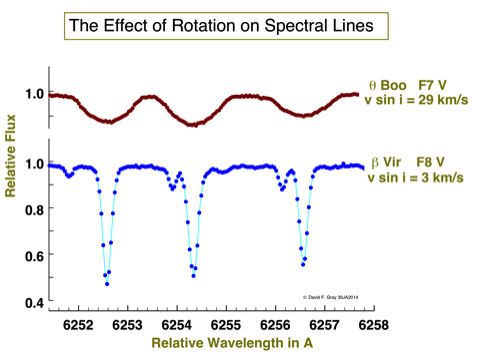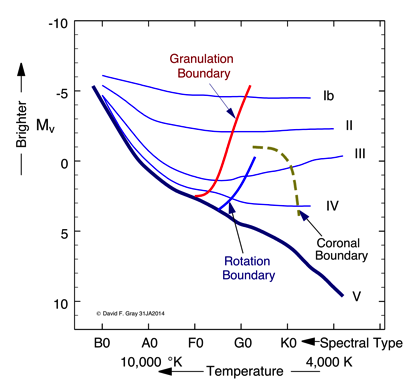A star's rotation can be measured by looking at the broadening of spectral lines, and from this we get the projected rotation rate, v sin i, and possibly information on differential rotation and limb darkening. Since it is the Doppler effect that produces the broadening of spectral lines, only the line-of-sight component of the rotation velocity is involved. The angle i is between the line of sight and the rotation axis of the star. Pole-on view has i = 0, no rotational broadening; equator-on view has i = 90 degrees, maximum rotational broadening. The rotation period can be measured by detecting rotational modulation caused by a non-uniform surface on the star. Spectroscopically we see rotation in the broadening of the spectral lines.
Stellar Rotation
When coupled with a convective envelope, rotation drives the magnetic activity of stars, which in turn produces dissipation of angular momentum through magnetic braking, temperature inversions in the outer atmosphere leading to chromospheric and coronal emission, and spots.
The total absorption in each line is not affected by the Doppler broadening, so as a line become wider, it also become more shallow. Some hot stars rotate as fast as ~ 450 km/s, while most cool stars rotate slower than ~ 6 km/s. Stars change their rotation rate over long timescale because of magnetic braking, changing moment of inertia as stars evolve, or exchanging orbital angular momentum in the case of binary stars.
There is a rather abrupt demarcation between slow and rapid rotators in the HR diagram called the ‘rotation boundary.‘ Stars on the hot side typically have a Maxwell-Boltzmann distribution of rotation rates, while stars on the cool side have one value for any given effective temperature and evolutionary status. This probably results from magnetic braking through the Rotostat Mechanism in which convection controls or modulates the rotation. More detail and explanation can be found in Photospheres and Lectures. There are exceptions to this general pattern. Close binary stars for example can pump orbital angular momentum into the component stars through gravitational coupling, making them rotate anomalously fast, or vice versa. RS CVn stars fall in this category and lie mainly between the rotation and coronal boundaries in the HR diagram.
Stars to the left of the rotation boundary have a wide range of rotation rates and are generally rapid rotators. Most stars to the right of the rotation boundary are slow rotators.


Some of my papers dealing with rotation can be found on a separate page.